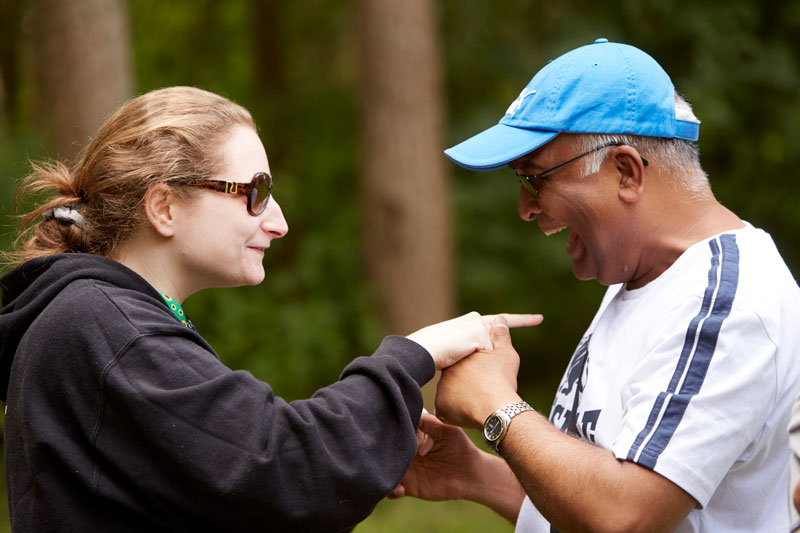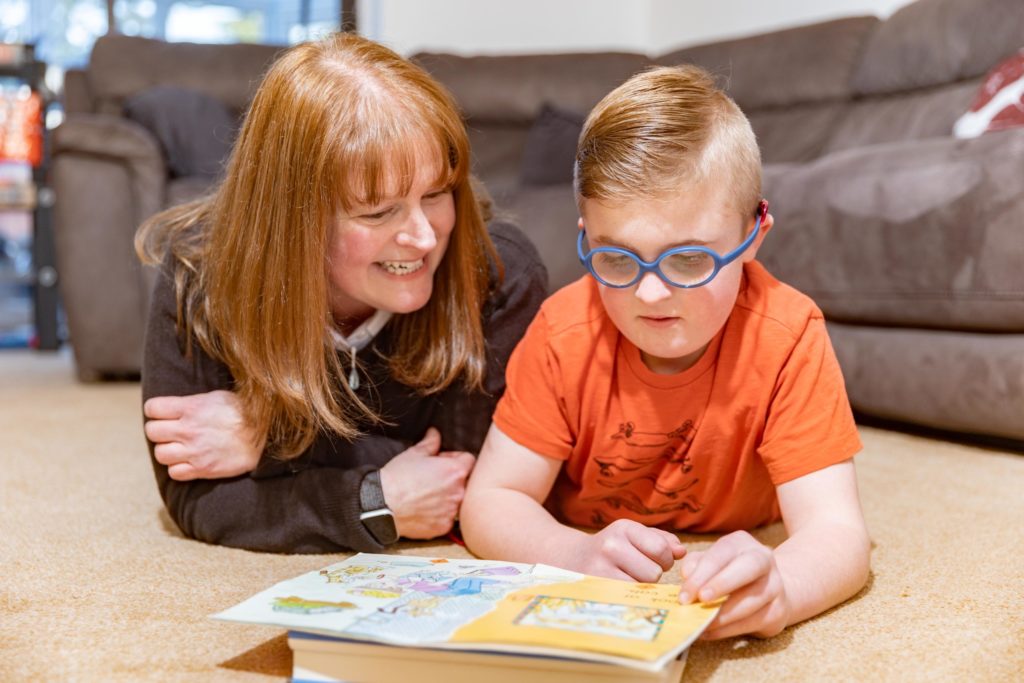Hand-under-hand communication
This page explains what the hand-under-hand approach is, who uses it and how it works. You can also watch an example of a conversation using hand-under-hand signing.
How Sense can help
We offer free and impartial information about living with complex disabilities, including deafblindness.
We also offer services all over the UK, including day services, community support and residential care. Talk to our team to find out more.
Get in touch by phone, email, post or through a BSL interpreter.
What is the hand-under-hand approach?
The hand-under-hand approach is a way of interacting and communicating using touch.
If you are a child or adult who is deafblind, your hands can act as your eyes, ears and voice.
To support someone who is deafblind using hand-under-hand, you can simply place their hand gently on top of yours.
Using this approach, the person who is deafblind can:
- Have more control.
- Play a more active part in tasks and learning.
- Focus on the objects they touch and not just on the other person’s hands.
- Connect to the world.
- Learn at their own pace.
Before you read on…
- You can communicate using a mix of different ways. (We all do!)
- At Sense, we use whatever combination of speech, touch, sign or visual language works best.
- It’s never too late to start.
- Have a go and don’t worry about getting it wrong.
With the hand-under-hand approach, if the person decides they want the activity to end, they can simply take their hand away at any time. This offers choice, control and a sense of freedom.
It’s a great approach for trying new activities, like introducing a child to a new way of playing.
Your child may be hesitant to put their hand directly on an unknown object, for example. Using hand-under-hand they can still join in.
The technique allows the person time to sense the movement of your hand, understand it is safe, and perhaps even feel comfortable enough to try it themselves, without your hand below theirs.
Who uses hand-under-hand signing?
Some people also use the hand-under-hand approach to communicate using sign language.

For example, Caroline was a British Sign Language user before losing her vision. As she became deafblind, she began to use hand-under-hand to communicate using BSL signs via touch.
Caroline also expresses herself in different ways, including with body language and facial expressions.
When someone is talking to Caroline, they use hand-under-hand signing so she can feel the signs they are using and vice versa.
Watch Caroline using hand-under-hand signing to communicate in this video.
Say Hello to Caroline video with audio description.
“Caroline started losing her vision as a teenager. As her vision deteriorated, Caroline found it harder to use British Sign Language, especially at a distance. But hand-under-hand signing meant her world opened up again. Caroline excels at bringing people into her world with hand-under-hand signing. The only problem is she sometimes signs so fast it’s hard to keep up with her.”
Sarah Turpin, senior MSI practitioner, Sense
Who uses hand-under-hand communication?
Hand-under-hand communication is used by children and adults who are deafblind.
When you have both hearing loss and sight loss, your hands can be an important tool for communicating and exploring the world.
How does the hand-under-hand approach work?
To use the hand-under-hand approach, allow the person who is deafblind to rest their hands on yours.
You can then guide, gently, from underneath. This gives the person the choice to move their hands freely.
The more opportunities a person has to use their hands and the safer it feels to explore, the more confident and motivated they will be to connect with the world, discover and learn.
You can use the hand-under-hand approach to:
- Introduce an object.
- Show how to do an activity or task.
- Encourage the person to get involved in things.
- Stimulate a person’s curiosity to reach out to the world beyond themselves.
- Prepare for and teach tactile signing.
- Explore items together through touch.
- Use on-body signing.
- Do things with the person, not for them.
Stay in touch

Get updates about our vital work, including volunteering, making a donation or supporting Sense campaigns.
How to get started with a child who is deafblind
- Let the child put their hands on top of yours to feel what you are doing.
- Practise doing this from different angles to see what works best.
- Work from behind the child so that your hands and the child’s move in the same direction.
- When the child is very young, sit them on your lap.
- When the child is older, sit behind them and reach your arms around.
- Let the child know you are going to do something by touching their shoulder or elbow.
- Bring an object up and under the hands of the child.
- Start an activity under the hands of the child and describe verbally what you’re doing with your hands.
- Before you show your child how to do something, try it yourself with your eyes closed. Pay attention to the steps you take.
- If the child pulls away, keep doing what you were doing and gently invite the child again to take part.
- If the child throws an object you are trying to show them, it’s OK to hold on to it tightly or move it.
- If the child chooses to show you that they like to throw things, this may be their way of coping with someone guiding their hands. So, if they do this:
- Find some suitable things to throw, let the child throw them and then you throw them.
- Try doing a little something with the object before you throw it, and with every throw, take a little bit more time.
Top tips
- Be patient, gentle and persistent.
- Most children need to try a new task several times before they learn it, so be patient.
- Some children don’t want to try new activities. They’ll pull their hands away and won’t want to touch.
- If they do this, try to respect what they’re telling you.
- But remember, if a child who is deafblind is never encouraged to try new things, learning will take longer.
- So, it’s OK to persist. Remember, though – don’t try to control. Just coax gently, allowing the child the freedom to choose and discover.
- And always remember to:
- Follow their pace.
- Be creative.
- Be flexible.
- Find things they are interested in.
Other types of communication
These are the main ways of communicating that we use:
-

Using touch
- Braille uses raised dots to touch.
- Deafblind Manual spells words on to your hand.
- Block alphabet spells letters on to your hand.
- Moon uses raised lines, curves and dots to touch.
- Tadoma uses lipreading by touch.
-

Using signs
- Sign language.
- Makaton, a simpler version of sign language.
- Visual frame signing for people with reduced vision.
- Objects of reference
-

Using speech
-

Also
- Non-formal communication without speaking, writing or signing.
- Intensive interaction treating everything as communication.
This content was last reviewed in October 2023. We’ll review it again in 2025.
